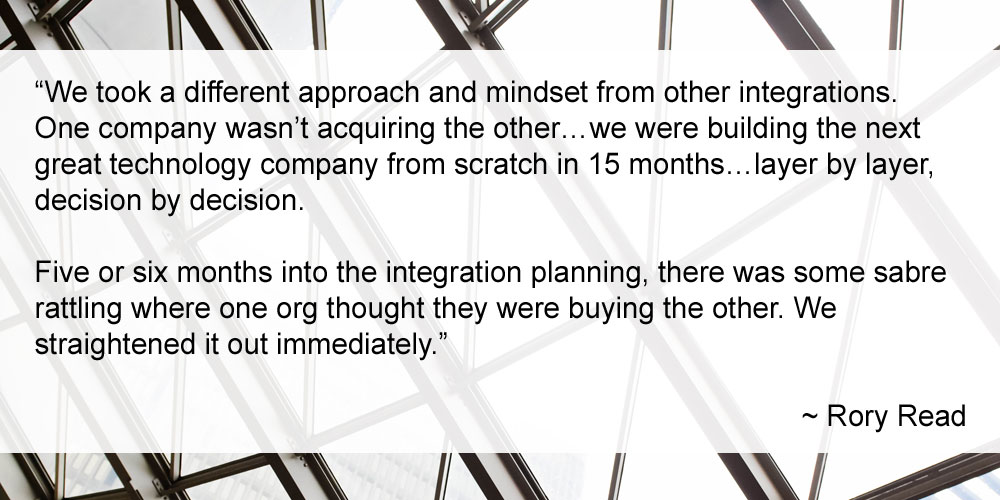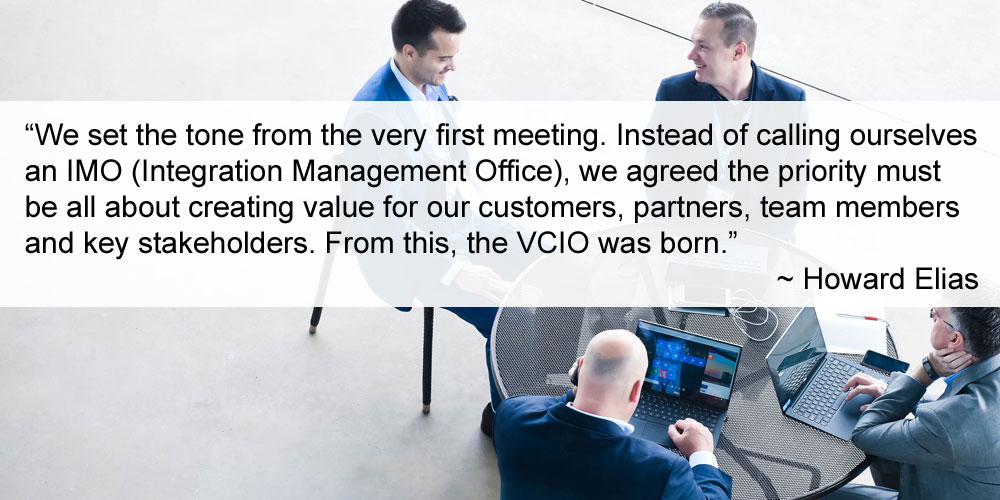The following is the first of two guest posts from John Powers, principal, Deloitte Consulting LLP (the second is here). Powers recently interviewed Rory Read, chief integration officer for Dell and chief operating officer, Dell EMC, and Howard Elias, president, Dell EMC Services and IT, for the Deloitte Module in CFO Journal, published by The Wall Street Journal. Following that, and many prior discussions, he gathered his thoughts here on the historical combination of companies that created Dell Technologies.

A Merger of Equals.
History says it’s not possible; Dell and EMC prove the exception.
Parity generally doesn’t exist. Sure, we like to believe it’s possible to achieve true equality in any given situation, whether it’s on the sports field or in the boardroom, but the truth is, in any meeting of equals, one player or executive group is likely to be just a little more equal than the other.
Such was the expectation when, in October 2015, Dell announced its intent to combine with EMC to form Dell Technologies in the largest technology deal in history. Billed as a merger of “two of the world’s largest technology franchises with leadership positions in servers, storage, virtualization, security and PCs,” the merger would create the world’s largest, privately controlled, integrated technology company with reach into 98 percent of the Fortune 500. The announcement was bold, to say the least.
The bold move, championed by Dell CEO, Michael Dell, would not only reinvent his company, but if successful, impact the entire IT industry by showing that long-established brands could still innovate and disrupt the sector in the same way as the young start-ups championed by the Silicon Valley venture capital firms on Sand Hill Road.
As ambitious as the announcement was, however, one question remained – could Dell pull off an integration of such complexity and magnitude? And, if so, how would the new $74 billion combined company with 140,000 team members and a massive partner/supplier ecosystem, ultimately perform?
The road toward integration was littered with “Deals from Hell,” to quote a famous book on the topic. So, how did Dell and EMC avoid the potholes along the way and achieve this rare feat? Specifically, we will look at the behind-the-scenes work that took place to make this merger happen, and study how two IT giants worked together to create a new organization that is greater than the sum of its parts.
The merger
Based on their long and successful histories, and their relative sizes in the technology marketplace, news of the proposed merger between Dell and EMC was announced on October 12, 2015.
Both companies had been serial acquirers, though each approached integration differently. Dell focused on tight integration, leveraging the significant synergies across their go-to-market approach, supply chain and corporate functions. EMC preferred to lightly integrate some of their acquisitions, focusing on scaling and amplifying their portfolio of companies, while tightly integrating others as the specific situation dictated. This merger, however, was something different; one computing leader combining forces with another. There was no standard playbook for something this complicated. Due to the scale and complexity involved in combining two massive organizations, they had the foresight to add both Bain & Company and Deloitte as trusted advisors to the team to support critical elements of the process.
It’s common to see the acquirer attempt to inflict their will on the acquired company, even when they call it a merger of equals. In the case of Dell and EMC, this was a true partnership with mutual respect. One core tenet throughout the entire process was the banishing of any notion that one team was acquiring the other. Michael Dell, MSD Capital, and Silver Lake took Dell private in 2012. The same collection of investors acquired EMC in 2016 and, through the blending of EMC and its various businesses (e.g. VMware) with Dell, formed Dell Technologies.

In short, this merger was anything other than business as usual for either Dell or EMC. In fact, The Wall Street Journal, on the day the deal was announced, called the merger “extraordinarily complex.” And, as such, it involved an incredible amount of trust, hard work, and consensus building toward a shared future direction for the two companies to be able to deliver on their promises to customers, employees, their respective communities, and their owners.
Michael Dell and Joe Tucci also had a strong and positive relationship, having managed a nearly $2 billion partnership together a decade earlier, which helped set a collaborative tone that reverberated across both organizations. The two companies would be coming together with very minimal overlap. But the road ahead would depend on far more than that.
Laying the foundation
Needing to evaluate the operating model of both companies as part of the proposed merger, Dell and EMC began the process by creating a foundational framework designed to address some of the biggest strategic questions at hand. The framework defined a roadmap of critical questions and decisions and assigned the questions to teams of experts from both companies. Rather than forming a standard integration task force, the companies set up a Value Creation Integration Office (VCIO) to manage the process from beginning to end, and to provide for rapid decision making.

The VCIO was led by one senior executive from each company — Rory Read from Dell and Howard Elias from EMC — who acted as the Chief Integration Officers. The two chaired a committee which surfaced and drove decisions around key strategic questions. Howard and Rory reported directly to the CEOs of their companies, effectively driving the merger so neither CEO was distracted from his current-year commitments.
In addition, high-performance leaders were hand-selected by senior management to form the VCIO team, which worked as a facilitating function while leaders remained embedded in their existing line organizations. When there were conflicting priorities, their commitment to the VCIO came first.
‘We chose the very best leaders from both companies, most of whom ended up with very big roles in the new company,’ said Rory Read
In choosing members of the VCIO, a litmus test was developed to determine their fit. It wasn’t about picking available manpower; it was about picking the best manpower, the “A players.” Among the key criteria used across the board when selecting VCIO teammates was a proven track record and reputation for being change agents, credible leaders, excellent communicators, and strong, positive, resilient team players with the ability to influence without authority.
As a result, Dell and EMC not only closed their record-setting merger in September 2016, but surfaced a number of invaluable lessons along the way that should be studied closely by any company entering into a similar arrangement.
In the second installment of this post, Powers will share those six lessons and dive into ways they can be applied to future mergers of all sizes.
 John Powers is Deloitte’s Global Corporate Development leader. He drives the inorganic growth strategy of Deloitte, in coordination with our global business and member firms.
John Powers is Deloitte’s Global Corporate Development leader. He drives the inorganic growth strategy of Deloitte, in coordination with our global business and member firms.
John, a principal in Deloitte Consulting LLP, formerly led Deloitte’s Defense Sector and its Mergers & Acquisitions (M&A) practice in the US and globally. Throughout his career, he has helped to execute several large M&A transactions, including the Dell/EMC merger, and the eBay/PayPal divestiture. His work has spanned the globe and has enabled the effective transition of more than 400,000 employees over the course of his career.
John is a visiting executive lecturer at the University of Virginia, Darden School of Business on the topic of merger integration. He joined Deloitte upon completion of his MBA from Northwestern University Kellogg School of Management in 1994 and graduated with a BA from Brown University in 1988. As an undergraduate, he received an Army Reserve Officer Training Corps (ROTC) scholarship and later served as an Army Finance Corps officer.
As used in this document, “Deloitte” means Deloitte Consulting LLP, a subsidiary of Deloitte LLP. Please see www.deloitte.com/us/about for a detailed description of our legal structure. Certain services may not be available to attest clients under the rules and regulations of public accounting.